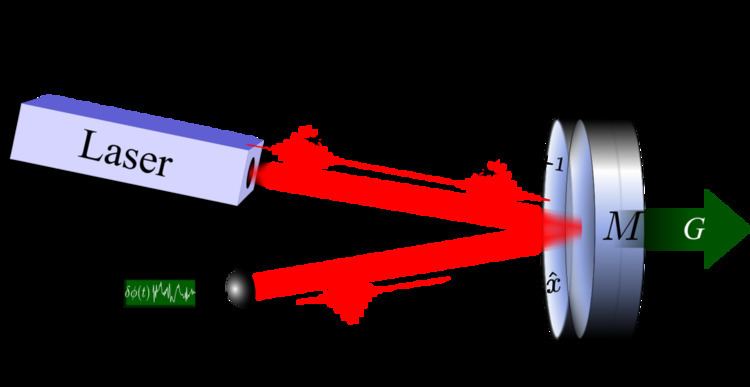 | ||
A quantum limit in physics is a limit on measurement accuracy at quantum scales. Depending on the context, the limit may be absolute (such as the Heisenberg limit), or it may only apply when the experiment is conducted with naturally occurring quantum states (e.g. the standard quantum limit in interferometry) and can be circumvented with advanced state preparation and measurement schemes.
Contents
The usage of the term standard quantum limit or SQL is, however, broader than just interferometry. In principle, any linear measurement of a quantum mechanical observable of a system under study that does not commute with itself at different times leads to such limits. In short, it is the Heisenberg uncertainty principle that is the cause .
A more detailed explanation would be that any measurement in quantum mechanics involves at least two parties, an Object and a Meter. The former is the system whose observable, say
At the same time, quantum mechanics prescribes that readout observable of the Meter should have an inherent uncertainty,
where
where
The terms "quantum limit" and "standard quantum limit" are sometimes used interchangeably. Usually, "quantum limit" is a general term which refers to any restriction on measurement due to quantum effects, while the "standard quantum limit" in any given context refers to a quantum limit which is ubiquitous in that context.
Displacement measurement
Let us consider a very simple measurement scheme, which, nevertheless, embodies all key features of a general position measurement. In the scheme shown in Figure, a sequence of very short light pulses are used to monitor the displacement of a probe body
Then each
where
The reflected pulses are detected by a phase-sensitive device (the phase detector). The implementation of an optical phase detector can be done using, e.g. homodyne or heterodyne detection scheme (see Section 2.3 in and references therein), or other such read-out techniques.
In this example, light pulse phase
For convenience, we renormalise Eq. (1) as the equivalent test-mass displacement:
where
are the independent random values with the RMS uncertainties given by Eq. (2).
Upon reflection, each light pulse kicks the test mass, transferring to it a back-action momentum equal to
where
with
and its RMS uncertainly is equal to
with
Assuming the mirror is free (which is a fair approximation if time interval between pulses is much shorter than the period of suspended mirror oscillations,
Its uncertainty will be simply
If we now want to estimate how much has the mirror moved between the
where we assumed all contributions to our measurement uncertainty statistically independent and thus got sum uncertainty by summation of standard deviations. If we further assume that all light pulses are similar and have the same phase uncertainty, thence
Now, what is the minimum this sum and what is the minimum error one can get in this simple estimate? The answer ensues from quantum mechanics, if we recall that energy and the phase of each pulse are canonically conjugate observables and thus obey the following uncertainty relation:
Therefore, it follows from Eqs. (2 and 5) that the position measurement error
Taking this relation into account, the minimal uncertainty,
This is the Standard Quantum Limit for such a 2-pulse procedure. In principle, if we limit our measurement to two pulses only and do not care about perturbing mirror position afterwards, the second pulse measurement uncertainty,
which is known as the Standard Quantum Limit for the measurement of free mass displacement.
This example represents a simple particular case of a linear measurement. This class of measurement schemes can be fully described by two linear equations of the form~(3) and (4), provided that both the measurement uncertainty and the object back-action perturbation (
Usage in quantum optics
In the context of interferometry or other optical measurements, the standard quantum limit usually refers to the minimum level of quantum noise which is obtainable without squeezed states.
There is additionally a quantum limit for phase noise, reachable only by a laser at high noise frequencies.
In spectroscopy, the shortest wavelength in an X-ray spectrum is called the quantum limit.
Misleading relation to the classical limit
Note that due to an overloading of the word "limit", the classical limit is not the opposite of the quantum limit. In "quantum limit", "limit" is being used in the sense of a physical limitation (e.g. the Armstrong limit). In "classical limit", "limit" is used in the sense of a limiting process. (Note that there is no simple rigorous mathematical limit which fully recovers classical mechanics from quantum mechanics, the Ehrenfest theorem notwithstanding. Nevertheless, in the phase space formulation of quantum mechanics, such limits are more systematic and practical.)
